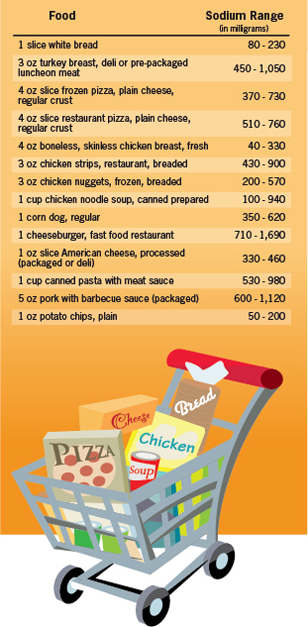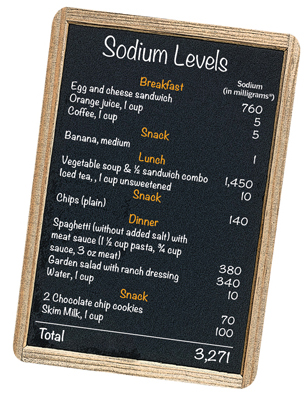Sodium and Food Sources
Most of the sodium we eat comes from packaged, processed, store-bought, and restaurants foods. Only a small amount comes from salt added during cooking and from being added at the table, and most Americans have already exceeded their daily limit of sodium before cooking or adding salt at the table. You can find out how much sodium you are eating by checking the labels on food products and adding up the milligrams of sodium. If at a restaurant, ask for nutritional information facts that include sodium.

Source: Mattes, RD, Donnelly, D. Relative contributions of dietary sodium sources. Journal of the American College of Nutrition. 1991 Aug;10(4):383-393.
Not all foods are created equal
Understanding sodium in foods can be confusing
| Top Sources of Sodium in the Diet |
|---|
| Breads and rolls |
| Cold cuts and cured meats |
| Pizza |
| Poultry |
| Soups |
| Sandwiches |
| Cheese |
| Pasta dishes |
| Meat dishes |
| Snacks |
- Types of foods matter: More than 40% of sodium comes from the following 10 types of foods: Breads and rolls, cold cuts and cured meats such as deli or packaged ham, or turkey, pizza, fresh and processed poultry, soups, sandwiches such as cheeseburgers, cheese, pasta dishes,* meat- mixed dishes such as meat loaf with tomato sauce, and snacks such as chips, pretzels, and popcorn.
- Sources of foods matter: About 65% of sodium eaten comes from food bought at retail stores, so look for lower sodium choices. About 25% comes from restaurants and it can be hard for a person to tell how much sodium is in restaurant foods.
- Brands of foods matter: Different brands of the same foods may have different sodium levels. For example, sodium in chicken noodle soup can vary by as much as 840 milligrams (mg) per serving.
*The pasta dishes category does not include macaroni and cheese. Macaroni and cheese is its own category.
Eating less sodium is a challenge
People who should limit their sodium to 1,500 mg a day are:
- People who are 51 years or older
- African Americans
- People with high blood pressure
- People with diabetes
- People with chronic kidney disease
- Americans eat on average about 3,300 mg of sodium a day. The U.S. Dietary Guidelines [PDF - 2.89MB] recommend limiting sodium to less than 2,300 mg a day, and about 6 in 10 adults should further limit sodium to 1,500 mg a day.
- Foods that otherwise seem healthy may have high levels of sodium (e.g., cottage cheese and turkey breast luncheon meat).
- Sodium is already part of processed foods and cannot be removed.
- Sodium is included in surprising ways. For example, much of the raw chicken and pork bought from a store has been injected with a sodium solution.
- Too many foods in restaurants are high in sodium.
- Some foods that you eat several times a day, such as bread, add up to a lot of sodium even though each serving is not high in sodium.
Who's At Risk?
Sodium levels of the same food can vary widely, so choose wisely.
This chart shows a range of sodium amounts in different types of food. Serving sizes may vary for some foods, e.g., bread slices which may be lower in sodium because of thinner slices.
Check the Nutrition Facts label which lists sodium content per serving. For help reading labels, visit Sodium Tip Sheet [PDF - 1.77KB].

Source: US Department of Agriculture, Agricultural Research Service, National Nutrient Database for Standard Reference, Release 24 and current manufacturer's data. Note: Values were rounded to the nearest 10 mg.

Sodium adds up quickly in our daily diet
Above is a sample diet of 3 meals and 3 small snacks with a total sodium content of more than 3,200 mg.
SOURCE: US Department of Agriculture, Agricultural Research Service, National Nutrient Database for Standard Reference, Release 24 and current manufacturer's data.
Note: Values greater than 10 mg of sodium were rounded to the nearest 10 mg.
Choose a Heart-Healthy Diet
The DASH eating plan (Dietary Approaches to Stop Hypertension) is a simple heart healthy diet that can help prevent or lower high blood pressure.
This diet is LOW in sodium, cholesterol, saturated and total fat, and HIGH in fruits and vegetables, fiber, potassium, and low-fat dairy products.
Making other lifestyle changes, like getting more physical activity, while on the DASH eating plan gives you the biggest benefits. Click here to learn more about the DASH Eating Plan.
Get email updates
To receive email updates about this page, enter your email address:
Contact Us:
- CDC/NCCDPHP/DHDSP
4770 Buford Hwy, NE
Mail Stop F-72
Atlanta, GA 30341-3717 - Call: 1-800-CDC-INFO
TTY: 1-888-232-6348
Fax: 770-488–8151
- cdcinfo@cdc.gov



